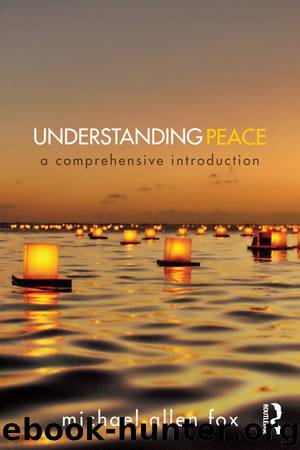Understanding Peace by Michael Allen Fox

Author:Michael Allen Fox
Language: eng
Format: epub
Publisher: Routledge
From this short sketch of Gandhi’s ideas and methods in action, we learn that nonviolence is much more than simply refraining from violence and from causing harm, and therefore, too, it is much more than just “the opposite of violence.” Likewise, nonviolence is just as much taking a stand in favor of something as it is refusing to do something else. Furthermore, it involves trying to see things from a conflicting viewpoint, where one’s opponent is coming from, as well as asserting one’s own personal power in various communicative and demonstrative ways.80 All of this explains, to a large degree, why Gandhi sought to recast nonviolence in his own novel manner.81
Gene Sharp and Contemporary Nonviolent Methods
Among the many theorists of nonviolent action to have been deeply influenced by Gandhi is Gene Sharp, who has spent an entire academic career clarifying and developing in detail the techniques by which this philosophy can be put into effective practice. His massive three-part work The Politics of Nonviolent Action (1973)82 is the standard authority on this subject; his book From Dictatorship to Democracy (1993),83 translated into more than thirty languages, has been described as “the most influential book you’ve never heard of”84 and has stimulated and guided protest movements in nations around the world, including Serbia, Ukraine, Georgia, Kyrgyzstan, Belarus, Iran, Lithuania, Latvia, Estonia, Yemen, and Egypt. The Albert Einstein Institute, which is dedicated to disseminating nonviolent literature and promoting the techniques of strategic nonviolence, reports unprecedented demand for Sharp’s book Waging Nonviolent Struggle at the present time.85 An Institute newsletter testifies that “Recent events [including the global Occupy movement] … have brought massive new attention to the power of these ideas and their potential for bringing about important changes in the world”86 The Politics of Nonviolent Action lists literally hundreds of methods of nonviolent action, described by Sharp as “political jiu-jitsu at work”87 These fall under the headings of “nonviolent protest and persuasion,” “social, economic, and political noncooperation,” and “nonviolent intervention.”88
Sharp’s general approach to nonviolence has two underlying premises. The first is that political power really belongs to the people, and therefore governments, as wielders of political power, remain so only by collective consent: “One can see people as dependent upon the good will, the decisions and the support of their government or of any other hierarchical system to which they belong. Or, conversely, one can see that government or system dependent on the people’s good will, decisions and support.… Nonviolent action is based on the second of these views.…”89 The next premise, following directly from the first, is that people have it within their power to withdraw the consent that invests power in the government (or other system), causing it to either change or collapse. Inasmuch as “political power is not intrinsic to the power-holder,” it derives from “the obedience and cooperation of the subjects.”90 As Peter Ackerman and Jack Duvall put it, withdrawal of consent means the power structure in place “would have neither the cooperation it needed to govern nor
Download
This site does not store any files on its server. We only index and link to content provided by other sites. Please contact the content providers to delete copyright contents if any and email us, we'll remove relevant links or contents immediately.
| Anthropology | Archaeology |
| Philosophy | Politics & Government |
| Social Sciences | Sociology |
| Women's Studies |
The remains of the day by Kazuo Ishiguro(8348)
Tools of Titans by Timothy Ferriss(7758)
Giovanni's Room by James Baldwin(6768)
The Black Swan by Nassim Nicholas Taleb(6731)
Inner Engineering: A Yogi's Guide to Joy by Sadhguru(6417)
The Way of Zen by Alan W. Watts(6264)
Asking the Right Questions: A Guide to Critical Thinking by M. Neil Browne & Stuart M. Keeley(5328)
The Power of Now: A Guide to Spiritual Enlightenment by Eckhart Tolle(5306)
The Six Wives Of Henry VIII (WOMEN IN HISTORY) by Fraser Antonia(5203)
Astrophysics for People in a Hurry by Neil DeGrasse Tyson(4981)
12 Rules for Life by Jordan B. Peterson(4150)
Housekeeping by Marilynne Robinson(4034)
The Ethical Slut by Janet W. Hardy(4018)
Skin in the Game by Nassim Nicholas Taleb(3951)
Double Down (Diary of a Wimpy Kid Book 11) by Jeff Kinney(3888)
Ikigai by Héctor García & Francesc Miralles(3842)
The Art of Happiness by The Dalai Lama(3827)
Skin in the Game: Hidden Asymmetries in Daily Life by Nassim Nicholas Taleb(3707)
Walking by Henry David Thoreau(3667)
